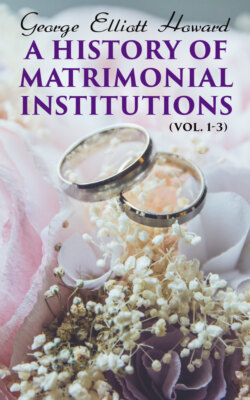Читать книгу A History of Matrimonial Institutions (Vol. 1-3) - George Elliott Howard - Страница 41
IV. PUBLICITY SOUGHT THROUGH BANNS AND REGISTRATION
ОглавлениеWithout doubt the wrong and confusion arising in the ecclesiastical theory and definition of marriage were manifold,h3 and they were patent to every observer. At the Council of Trent it was asserted that some action to put a check upon clandestine marriages was demanded by all the temporal powers;[1150] and the provincial church councils, aided by state legislation, had done what they could by imposing; penalties to remedy the abuse.[1151] Nevertheless, strange as it may seem to one not acquainted with the devious logic of scholastic theology, many members of the Council of Trent, on dogmatic grounds, were stubbornly opposed to the only reform which experience showed could be effective. They affirmed that severer discipline would suffice. They apologized for clandestine marriages on the pretext that they are sometimes useful, even necessary; or they denied that to declare them null would prove an efficient remedy.[1152]
Hence we are better able to appreciate at its true value the significance for the Catholic world of the victory gained by the common-sense of the majority. It was a victory in favor of that publicity which the state demanded. Indeed, the church had already done something, in spite of dogma, to change marriage from a private to a public transaction. Her collision with the state, her anomalous position with respect to social order, was involuntary. She was caught, as it were, in the meshes of her own philosophy. Yet in the interest of morality she strove to secure publicity. The priest at the nuptials, declares Sohm, "appears first of all as a public person."[1153] In particular the church tried to gain publicity for marriage by the institution of banns. The custom of publishing banns seems first to have made its appearance in France, probably as early as the fifth century.[1154] It is enforced by the capitulary of 802, which gains its real significance from this fact, and not from the mention of the priestly benediction.[1155] From France it gradually made its way into other countries of Europe. Thus in the year 1200, as already noted, banns were enforced by Archbishop Walter; and they were first made a general requirement by Innocent III. at the fourth Lateran council in 1215.[1156] Later the English archbishops found it necessary from time to time to impose more stringent penalties for neglect of the proper publication of banns;[1157] and they were enforced, without making the publication essential to a valid marriage, by the Council of Trent. From the twelfth century onward the marriage rituals contain directions for the asking and publication of banns;[1158] while the punishment of persons guilty of violating the canons in this regard gave much employment to the spiritual courts during the Middle Ages.[1159]
The institution of banns has a special historical interest as being in some sense the mediæval substitute for the modern registration and official license to wed. The practice was to announce the marriage, usually on three successive Sundays preceding the nuptials, that any objection on the ground of relationship or other disability might be brought forward. But the decrees of the church were not carefully enforced. Dispensation from the obligation to publish banns was the right of the bishop, but his license was usually granted only in favor of the nobility and higher classes; and the right constituted an important source of revenue.[1160]
The year 1538 marks an important epoch in the administration of English matrimonial law. It was then, according to the researches of Burn, that parish registers of births, deaths, and marriages were first introduced; although before this time it had been customary in some places to inscribe such records in the missals and psalters of the church.[1161] The first article of the injunctions issued by Thomas Cromwell, vice-regent under Henry VIII., provided: "Item, That you and every parson, vicar, or curate within this Diocese, for every Church keep one Book or Register, wherein he shall write the day and year of every Wedding, Christening, and Burial, made within your parish for your time, and so every man succeeding you likewise, and also there insert every person's name, that shall be so wedded, christened, and buried. And for the safe keeping of the same Book the parish shall be bound to provide of their common charges one sure coffer, with two locks and keys, whereof the one to remain with you, and the other with the Wardens of every parish wherein the said Book shall be laid up, which Book ye shall every Sunday take forth, and in the presence of the said Wardens or one of them, write and record in the same, all the Weddings, Christenings, and Burials made the whole week afore, and that done, to lay up the Book in the said coffer as afore; and for every time that the same shall be omitted, the party that shall be in the fault thereof, shall forfeit to the said Church iijs. iiijd. to be employed on the reparation of the said Church."[1162]
Thus in this, the most ancient English registration act, the parson or incumbent appears as the original registrar; and that the importance of keeping such record was keenly appreciated is shown by the anxious, almost painful, minuteness with which his duties are defined. The order of Henry VIII. was enforced or supplemented under Edward VI., Elizabeth, William III., and other monarchs; but, save during the Commonwealth, no material change was made in the mode of registration until in 1836 the present system was introduced.[1163]
